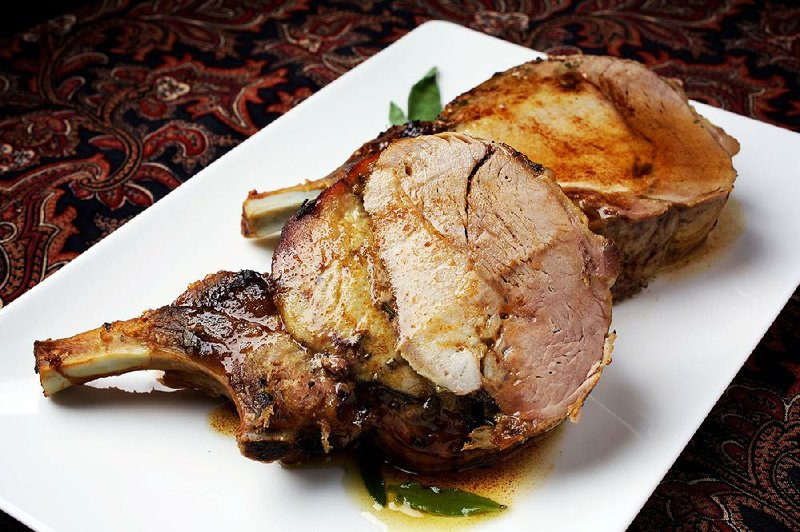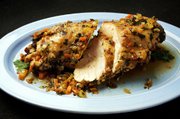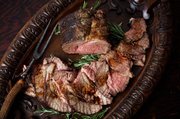Florence's most iconic dish is, without a doubt, bistecca alla fiorentina: an enormous porterhouse steak, minimally seasoned with salt and pepper, grilled and served bloody rare. It's a showstopper, for sure. But it's not for everyone, or for every occasion. Less well known, but just as worthy, are the simple roasts served in the city's cozy trattorias, in family-run restaurants in the countryside and in home kitchens throughout the Italian region of Tuscany.
Simply prepared roasts have a long history in Tuscan cuisine. Arista di maiale, a bone-in pork loin roast seasoned simply with herbs, garlic and white wine, dates to at least the 15th century, when it was served at an assembly of bishops in Florence. "Rosbiffe," the Italian adaptation of roast beef, is a more recent import, arriving in the 1800s with a large British expatriate community that settled in Florence.
I consulted with Tuscan cookbook authors Giulia Scarpaleggia and Emiko Davies, as well as Florentine butcher Andrea Falaschi, and Virginia butcher David Burton of The Organic Butcher in McLean to compile this list of tips for successfully making a Tuscan-style roast:
• Make sure the meat is at room temperature.
• Tie the meat with kitchen string. (I tie at 1-inch intervals.) This will ensure even cooking, plus it makes for a more attractive roast that slices neatly. If the roast is encased in plastic mesh, discard it for cooking and tie the roast with kitchen twine. If the mesh is cotton, it can stay in place.
• Season with a mixture of fresh -- not dried -- herbs, plus salt and pepper. Rub the seasoning all over the meat (think of it as a massage), making sure to coat it evenly.
• Choose the right roasting pan or pot. Many Tuscans cook their roasts in a pot on the stove top, in a method (oddly) known as arrosto morto, or "dead roast." Choose a heavy-bottomed pot into which the roast fits snugly (so any juices that accumulate during cooking don't evaporate) but is not crowded. For oven roasting, select a hefty roasting pan, a ceramic baking dish or an ovenproof skillet. Again, be sure the roast fits snugly in the pan but is not crowded. A roasting rack is optional; it promotes even cooking, but pan drippings tend to evaporate more quickly, especially in a hot oven.
• Sear the meat. Most roasts benefit from an initial browning on the surface to enhance flavor and create a crust. This is easily done on the stove top in a little hot oil or fat. Turn the meat to brown it on all sides. (The exception here is the accompanying recipe for the pork, which is browned in the oven at the end of roasting, to crisp the skin.)
• Roast at a low to moderately low temperature: low heat for the stove top and anywhere from 275 to 350 degrees in the oven. That will allow the roast to cook properly and evenly without becoming tough.
• An instant-read thermometer is the easiest and most accurate method to check for doneness.
• Let the roast rest for 15 minutes before serving; it helps redistribute the juices and makes for a juicier roast.
• Slice the meat thinly, arrange the slices overlapping on a warmed serving platter and spoon the pan juice on top. (Again, the exception here is the pork, which can be either cut into thick chops or removed from the bones and sliced thinly.)
Tuscan-Style Roast Beef "Rosbiffe"
1 (3-to-4-pound) top round roast or Wagyu top round roast, tied with kitchen twine at 1-inch intervals
2 teaspoons fine sea salt
1 teaspoon ground black pepper
2 tablespoons sunflower oil or olive oil
3/4 cup Sangiovese or other robust red wine
2 sprigs rosemary
1 clove garlic, crushed
Heat oven to 325 degrees.
Pat the meat dry with paper towels. Season it all over with the salt and pepper.
Heat the oil in a heavy, ovenproof pot or small roasting pan over medium-high heat. Once the oil shimmers, add the meat and brown it on all sides, using tongs to turn it every couple of minutes.
Pour the wine into the bottom of the pot (not over the meat), then toss in the rosemary and garlic. Transfer to the oven and roast, uncovered, for 1 to 1 1/2 hours (about 20 to 25 minutes per pound) or until an instant-read thermometer inserted into the center of the meat registers 120 (rare) to 125 degrees (medium-rare).
Use tongs to transfer the beef to a cutting board; tent it loosely with aluminum foil. Let it rest for at least 15 minutes, then discard the twine and the spent rosemary. Cut the meat into thin slices, slightly overlapping them on a platter as you work.
Spoon the pan juices over the slices -- mashing the roasted garlic in them first, if you wish -- and serve.
Makes 6 to 8 servings.
There's a reason this bone-in pork roast has been a Florentine favorite since the 15th century: It is simple and elegant, a perfect dinner party centerpiece. Also, it's versatile: It can be cut into thick chops or thin slices. In summer, Florentines enjoy arista cold, thinly sliced and drizzled with good olive oil and a squeeze of lemon juice.
Florentine Pork Loin Roast Arista di Maiale
1 (2 1/2-to-3-pound) "frenched" bone-in pork loin roast, preferably with a thin layer of fat
1/4 cup extra-virgin olive oil, divided use
10 leaves fresh sage
Leaves from 1 sprig rosemary
2 cloves garlic
1 teaspoon fine sea salt
3/4 teaspoon ground black pepper
3/4 cup dry white wine, such as Vernaccia di San Gimignano, plus more as needed
Chicken or beef broth, as needed
Heat oven to 350 degrees.
Prepare the roast (or have the butcher do it): Use a sharp knife to cut all along where the bones meet the loin, as if you were removing the row of bones completely, but leave it attached by about 1 inch at the bottom. Rub a couple of tablespoons of the oil all over the roast.
Finely chop the sage, rosemary and garlic, combining them in a small bowl as you work. Add the salt and pepper and mix thoroughly. Spread half of that mixture into the cut along the bone. Rub the rest all over the roast. Tie the roast with kitchen twine to hold it together, wrapping the string at intervals between the ribs. Wrap the exposed, individual rib bones in aluminum foil to protect them from burning during cooking.
Place the pork on a roasting rack in a roasting pan. Drizzle the remaining oil over the pork, then pour the wine over it. Roast for about 1 hour or until the center of the meat registers 155 degrees on an instant-read thermometer. (Start checking the temperature after 45 minutes so you can properly gauge the progress.) (If the liquid in the pan becomes scarce during cooking, add another splash of wine or a splash of chicken or beef broth.)
Remove the roast from the oven; increase the temperature to 475 degrees. Once it reaches that temperature, return the roast to the oven for about 5 minutes, just to crisp the surface. Transfer the roast to a cutting board and tent lightly with foil. Let it rest for at least 15 minutes.
To serve, cut the roast into thick chops, using the bones as your guide. Or detach the meat from the bones and cut the roast into thin slices. Spoon the pan drippings over the meat.
Makes 4 to 6 servings.
Roasted with aromatic vegetables and herbs like an Italian veal roast, a boneless turkey breast presents a nice alternative to a more expensive centerpiece for a small dinner party.
Stove-Top Roasted Turkey Breast Arrosto Morto di Tacchino
1 (2 1/2-pound) boneless turkey breast, tied with string or bound with mesh
3 tablespoons extra-virgin olive oil, divided use
2 tablespoons minced fresh herbs such as a mix of parsley, sage and rosemary
1 teaspoon fine sea salt
1/2 teaspoon ground black pepper
2 tablespoons unsalted butter
1 small carrot, scrubbed well and finely chopped
1/2 celery rib, finely chopped
1/2 small onion, finely chopped
1/2 cup dry white wine, such as Vernaccia di San Gimignano, or more as needed
1/2 cup dry Marsala
Chicken or beef broth, as needed
Pat the roast dry with paper towels. Rub 1 tablespoon of the oil all over the turkey, then sprinkle the fresh herbs all over it. Season with the salt and pepper.
Combine the remaining 2 tablespoons of oil and the butter in a small, heavy pot or Dutch oven over medium-high heat; once the butter has melted and begins to sizzle, add the turkey breast and brown on all sides, using tongs to turn it every couple of minutes. Transfer to a plate.
Add the finely chopped vegetables to the pot; reduce the heat to medium-low and cook, stirring often, until the vegetables have begun to soften and turn translucent, about 8 minutes.
Return the meat to the pot and pour in the wine and Marsala. Reduce the heat to low, partially cover the pot and cook for 45 minutes to 1 hour (about 15 to 20 minutes per pound) or until the internal temperature of the meat taken near the center registers 165 degrees on an instant-read thermometer. The meat should be fully cooked, with no hint of pink in the juices when pierced. (If the liquid in the pot becomes scarce during cooking, add another splash of wine or a splash of chicken or beef broth.)
Use tongs to transfer the turkey to a cutting board; tent it loosely with aluminum foil. Let it rest for at least 15 minutes; cover the pot during that time to keep the pan juices warm. If you'd like to create a smooth sauce, use an immersion blender to puree the pan juices and cooked vegetables.
Remove the string or mesh and cut the turkey into 1/3-inch-thick slices. Arrange them, slightly overlapping, on a platter. Spoon the pan juices or sauce over the slices and serve.
Makes 4 servings.
Marchetti is a food writer, recipe developer and cooking teacher who specializes in seasonal Italian cooking.
Food on 01/17/2018


